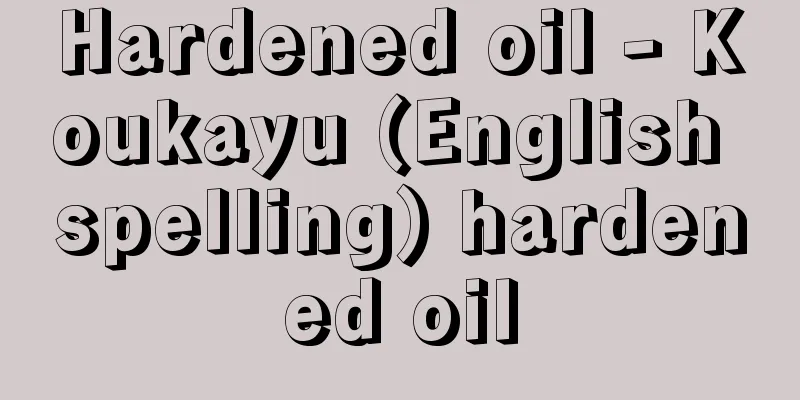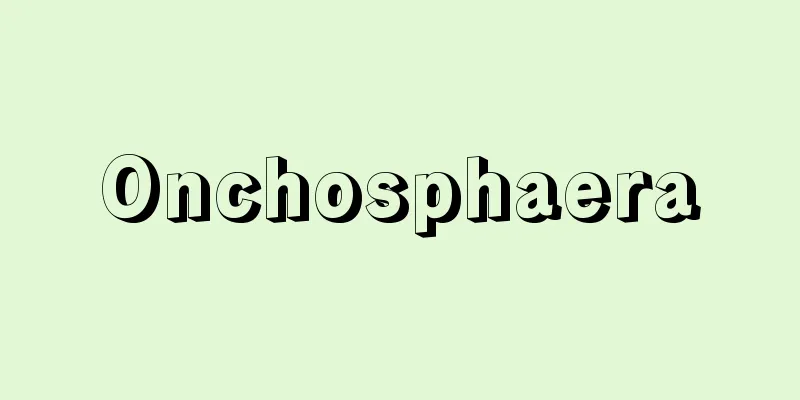Hardened oil - Koukayu (English spelling) hardened oil

|
It is a white solid fat obtained by hydrogenating fatty oils such as fish oil, soybean oil, and rapeseed oil. Some are made from fats such as palm oil and beef tallow. Partial hydrogenation is often performed, and this is called semi-hardened oil. The raw oil contains unsaturated fatty acids such as oleic acid, linoleic acid, linolenic acid, and highly unsaturated fatty acids as its component fatty acids, but in hydrogenated oil, hydrogen is added to the unsaturated fatty acids, reducing the unsaturated fatty acids and eventually becoming saturated fatty acids, which can become solid fats. During the hydrogenation process, the unsaturated fatty acids produce a large number of isomers. The color improves, the odor decreases, the iodine value and refractive index decrease, and the melting point increases and becomes stable. To hydrogenate industrially, the raw oil is placed in a reactor, heated, moisture and air are removed, a nickel catalyst is added, the mixture is stirred, and hydrogen is introduced and pressurized. The oil that accumulates at the bottom of the reactor is added in a fine rain from the top of the reactor and the reaction is continued. The reaction conditions for hardened oil are usually 4 atmospheres and 180°C. Selective hydrogenation refers to the selective hydrogenation of specific unsaturated parts (for example parts with two or more double bonds) in the raw oil. In this case, 1.5 to 3 atm and 175°C are appropriate. Setting the reaction conditions is complicated, and hydrogenation is usually carried out by the batch method. There is also a continuous method. The uses of hydrogenated oil are margarine, edible oil, soap raw material, and raw material for fatty acid and glycerin production. [Kazuo Fukuzumi] [Reference items] | | |Source: Shogakukan Encyclopedia Nipponica About Encyclopedia Nipponica Information | Legend |
|
魚油、大豆油、菜種油などの脂肪油に水素添加した白色固体脂肪である。パーム油、牛脂など脂肪を原料とするものもある。部分的に水素添加することも多く、これを半硬化油という。原料油は成分脂肪酸としてオレイン酸、リノール酸、リノレン酸、高度不飽和脂肪酸などの不飽和脂肪酸を含むが、水素添加油は不飽和脂肪酸に水素が添加して不飽和脂肪酸が減少し、ついには飽和脂肪酸となり、固体脂肪となりうる。水素添加途中で不飽和脂肪酸は多数の異性体を生成する。色調はよくなり、臭気は減少し、ヨウ素価、屈折率は低くなり、融点は上昇し安定になる。工業的に水素添加するには、原料油を反応器中に入れてから、加熱し、水分および空気を除去し、ニッケル触媒を加え、攪拌(かくはん)し、水素を導入加圧する。反応器下部にたまる油を反応器頂部から細雨状に入れることを繰り返して反応させる。硬化油の反応条件は通常4気圧、180℃である。原料油中の特定の不飽和部分(たとえば二重結合二つ以上を有する部分)を選択的に水素添加することを選択的水素添加という。この際1.5~3気圧、175℃が適当である。この反応条件設定は複雑であり、通常、水素添加は回分法で行われる。連続法もある。硬化油の用途は、マーガリン、食用油、せっけん原料、脂肪酸およびグリセリン製造原料である。 [福住一雄] [参照項目] | | |出典 小学館 日本大百科全書(ニッポニカ)日本大百科全書(ニッポニカ)について 情報 | 凡例 |
Recommend
X organ - sinus gland system
…Although it is called a gland, it is not an inde...
Pityrogramma triangularis (English spelling) Pityrogramma triangularis
…[Shigeyuki Mitsuda]. … *Some of the terminology ...
Fukui Cave - Fukui Cave
A small sandstone cave in Yoshii-machi, Nagasaki P...
Fin movement - Kiko
…On the other hand, animals that only touch the g...
available relief
...So, for example, a grid with the distance betw...
Sabellius
Sabellianism was a heresy (along with Arius) that ...
Subcutaneous emphysema - Hikakishu
Air enters the subcutaneous tissue, mainly due to ...
Spade (plow) - Spade (English spelling)
A manual agricultural tool with a vertical or obtu...
Straddle
The name of hunters (Karyudo) of Tohoku mountain ...
Society of Friends
The Japanese name for Quakers, also known as the F...
Cave Monasteries of Cappadocia - Cappadocia Cave Monasteries
…In addition, excellent mosaic art flourished ove...
Skirōn (English spelling) Skiron
…The Procrustean bed, which is still used today t...
Ammonia oxidation method - Ammonia oxidation method
This method involves oxidizing ammonia NH3 to pro...
Kabutomaru - Kabutomaru
... E . pentalophus var. procumbens (Eng.) Krainz...
Foreign company - gaikokukaisha (English spelling) foreign company
A corporation or other foreign organization establ...



![Shimonita [town] - Shimonita](/upload/images/67cbcb927b7a3.webp)





